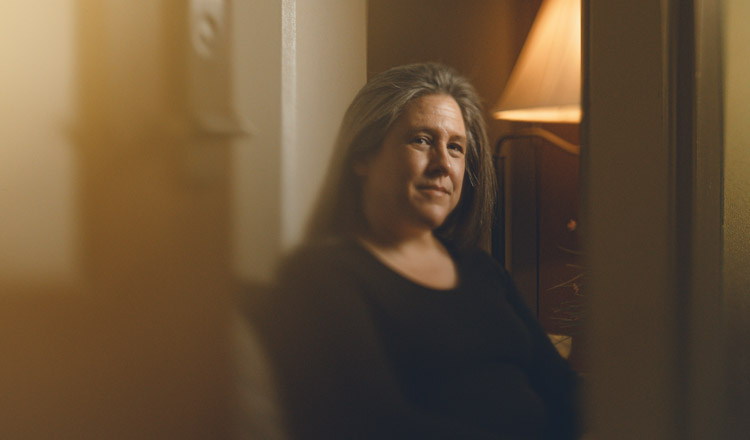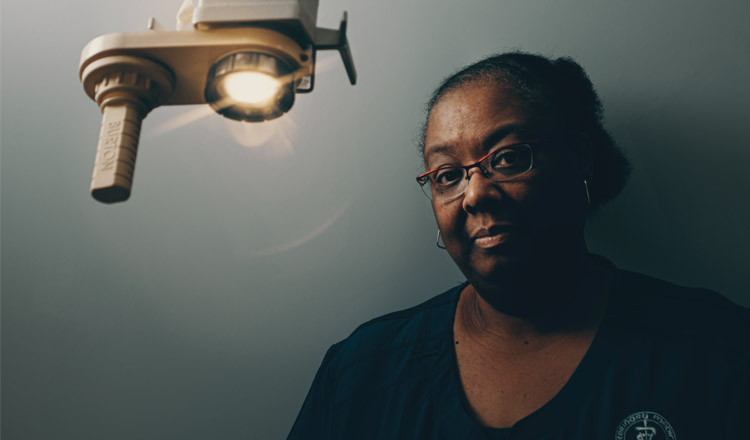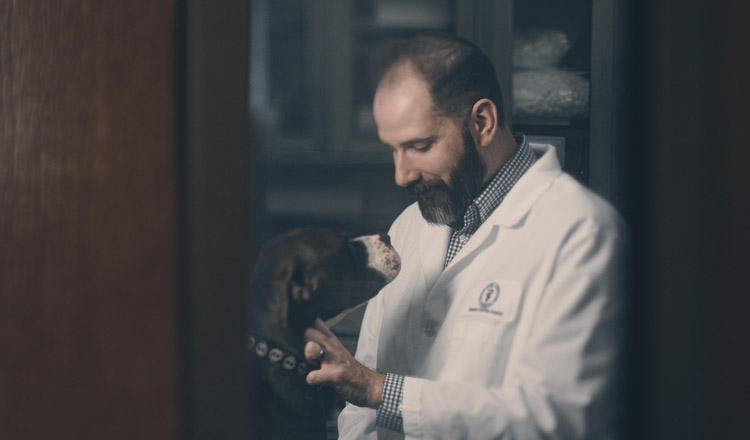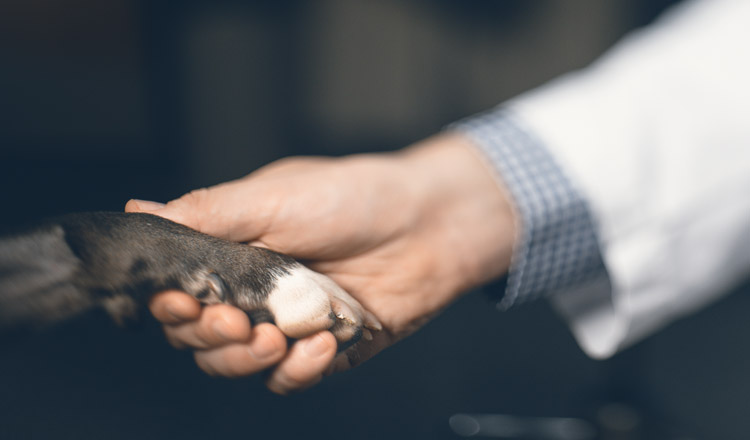Saddled with stress, debt, and death, veterinarians commit suicide at twice the rate of the general population.
The College of Veterinary Medicine expanded its staff and its resources to provide support for mental health.
In front of the Purdue University Veterinary Teaching Hospital stands Continuum, one of the most visually compelling sculptures on West Lafayette’s campus. Spanning 45 feet — and 20,000 years — Continuum shares the story of an evolving and increasingly intimate relationship between humans and animals.
Watching veterinary students parade a happy pack of Labradors around the perimeter of the hospital, it’s easy to relish the opportunity to work alongside man’s best friend for a living. But it’s not without its challenges

“Pets are becoming more like family members,” says Jennifer Dehn (HHS’95). “When that family member is sick or ill or at the end of their life, it’s a bigger loss than it used to be.”
A licensed social worker, Dehn joined the staff at Purdue’s veterinary hospital in May 2019 to help facilitate some of those challenging conversations — and to make sure that the staff is cared for as well.
At a time when there is a growing national spotlight on mental health and suicide rates are at their highest point since World War II, the epidemic is hitting veterinary medicine even harder than the general public.
A 2018 study by the Centers for Disease Control and Prevention found that women veterinarians were 3.5 times more likely to die by suicide than the general population. Male veterinarians were 2.1 times more likely.
Though there’s more to these statistics than the sorrow of putting down people’s treasured companions, it’s certainly a contributing factor.
Studies show, for example, that veterinarians skew toward introverted, type A personalities. And while veterinarians receive well-rounded training on how to treat multiple species, you can’t treat the animal without managing the human relationship as well.
Some clients show up at the emergency room with a pet that’s bleeding because of a broken nail. Some clients are negligent. Many want to do what’s best for their pet but face limited options because of finances.

Paula Johnson, clinical assistant professor in Purdue’s small animal emergency and critical care unit, shares the difficulty this can present for staff.
“We become the bad guy. People will say things along the lines of, ‘You’re just going to let my pet die!’ or, ‘You don’t care about my pet!’
“In an emergency situation, we don’t meet people at their best, but it’s still hurtful — especially when you’re trying to do the very best you can for them and their pet.”
And when things go wrong, angry clients often take to the internet to vent their frustrations. Spend 10 minutes browsing reviews for almost any veterinary clinic, and you will find numerous complaints accusing the staff of a lack of empathy and compassion.
With limited training in client interaction and often no business experience, veterinarians are responsible to step into people’s lives at a moment of extreme duress and meet the client wherever they are — while operating on razor margins.
“I don’t care what anyone says, veterinary medicine is not a moneymaker,” says Johnson. “People have a passion for what they’re doing — this is something they truly want to do. Debt-to-income ratio after you graduate is upside down.”
While the amount of debt that veterinarians accrue is comparable to that of medical doctors — approximately $167,000 for veterinarians compared with $190,000 for medical doctors — the pay for veterinarians is significantly lower. Starting salaries are typically under $100,000. Higher-earning positions require competing for a scant number of residency positions at less than 30 veterinary colleges in the United States.

Learning to set boundaries
For a veterinarian, professional success is defined by the health outcomes they are able to achieve. Lives saved. Animals reunited with family after an accident. Another day, month, or year of walks, squirrel chasing, ear scratches, and belly rubs.
When things don’t go according to plan, the consequences can weigh heavily on the entire staff — not just the doctor.
And over time, the effects can be disastrous.
Carrie Jurney, board member of Not One More Veterinarian, a group founded in 2014 to create space for veterinary professionals to talk about mental health, found herself at the end of her rope.
“I went from ‘This job is all that I am,’ to, ‘I can’t do this anymore,’” she says. “I had to take four months off and analyze what was happening in my life. I was helping all these other people when I needed a lot of help.”
The passion that drives people to become veterinarians is a double-edged sword. Wanting to help animals means that veterinarians and veterinary nurses want to go the extra mile to do what they can to help their clients. But it can also mean white-knuckling through each challenge without taking the time to step back from the edge.

“I know I was raised with a certain work ethic — you keep going,” says Christine (Bongiorno) Coyle (DVM’98). “In 22 years, I have called out three times. I missed one week for abdominal surgery, even though I should’ve missed two, and I worked one day with a severe corneal ulcer and then went to the ER.”
Coyle isn’t alone.
“I know similar stories from many of my colleagues, including one who worked with severe back pain, even sitting to do surgery until she ended up in the ER heading to back surgery for herself!”
Dehn stresses how important it is for people to establish their limits. “I hear that often the boundaries weren’t there,” she says, referring to instances of suicide in the profession. “They weren’t able to turn off the veterinary profession and turn on the family or the hobby. They kind of all merged together, and that’s kind of a hard place to be for someone in helping professions.”

Christopher Fulkerson (HHS’06, DVM’10, MS V’14), clinical assistant professor of medical oncology at the Purdue teaching hospital, breaks down some of the complexities around setting boundaries.
“There seems to be an expectation — not only from clients but often from ourselves — that we should be directly available 24 hours a day,” Fulkerson says. “Technology has certainly facilitated this, but even before email, text messages, paging, and social media, veterinarians have a long history of making themselves directly available to the public — to a degree that would never be expected of a physician or a dentist. And that’s not a dig at physicians or dentists; it’s OK for them to set boundaries, too!”
As part of her work at the Purdue University Veterinary Teaching Hospital, Dehn would like to be able to help students think outside the walls of the hospital.
“I would really like to see students come out of school with a better understanding of themselves and what works for them in terms of coping skills and what doesn’t work,” Dehn says. “Getting to know themselves — not just who they are in an academic setting trying to get the grade. It’s easy to lose yourself and forget why you’re there.”
To help students, Purdue has hired two additional professionals who will focus on student needs during their first three years of vet school, while Dehn will work in the hospital with fourth years, staff, and clients.
Helping the helper
While social workers have long been integrated with human medicine to help facilitate client interaction when it comes to life-death decision making, they are a recent — and as of yet, fairly rare — addition to veterinary medicine.
For many, this is a welcome development to assist with cases that veterinarians lack appropriate training to handle. Johnson recalls a client from her time as a student at Louisiana State University.
“A lady brought her cat in, and it was dead,” says Johnson. “She didn’t believe it was dead. She was way over the top, and having to deal with her and worrying about what would happen if we just turned her loose out the door after the way she came in was horrifying.”
While incorporating social workers into the veterinary workforce has had its positive effects, there are limitations.
“Affording someone like that could be an issue for our small businesses that already run close to the margin at times,” Coyle says. Even apart from the financial constraints, the conversation will likely have to come back to the veterinarian.
“When I think about the discussions I’ve had to have with clients about end-of-life care or decisions for their pet, I actually think we are the best go-to,” Coyle says. “This is hard on us of course, but I also find that for me personally, it’s gotten easier as you learn how to communicate with different types of clients.”
Who should consider veterinary medicine as a profession?
Before entering the profession, Dehn does recommend that people take time to assess themselves.
“Before starting such a demanding profession, it’s important to make sure you really know yourself and go into it with open eyes, knowing that it’s a hard program and knowing you have a support system in place. Wherever you go to school, look at what sort of support systems there are, and don’t be afraid to use them.”
In a profession that tends to attract introverts, Johnson also stresses the importance of being able to build trust and strong relationships with clients.
“Engagement needs to be taken on by the profession as a whole to tell people it’s great you love animals, but the owner isn’t going to let you touch her cat if she doesn’t trust you. You need to be able to know how to alleviate her concerns.”
Mental Health Resources
If you or someone you know needs immediate help, please call 1-800-273-8255 (TALK). Through this toll-free phone number, you can be connected with someone who is trained to listen and offer support to people in emotional crisis. You can also text the crisis line and be connected with someone by texting HOME to 741741. If you feel someone is in imminent danger, call 911.
Purdue students can access mental health services through the Counseling and Psychological Services (CAPS). Faculty, staff, students, or others who are concerned about a student’s behavior are encouraged to report the concern to an appropriate university representative or the Office of the Dean of Students or submit the concern.
If you are a client at the Purdue University Veterinary Teaching Hospital and would like to talk with someone about a pet loss, assistance with managing a chronic illness with your pet, or adjusting to changes in your pet’s health, please visit the Purdue Client Support and Counseling Services website or call 765-496-6718.

